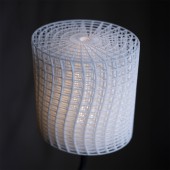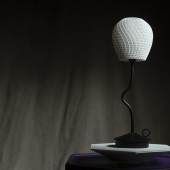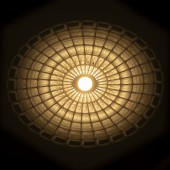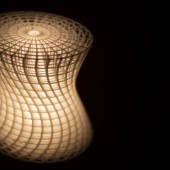Quintessence Spectrum Series Portable Table Lamp by Jeffrey Geiringer |
Home > Winners > #159084 |
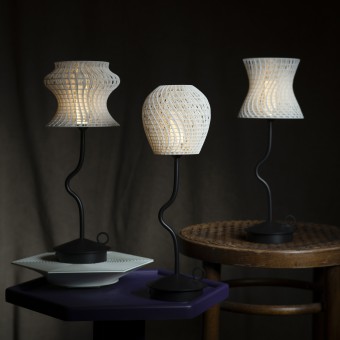 |
|
||||
| DESIGN DETAILS | |||||
| DESIGN NAME: Quintessence Spectrum Series PRIMARY FUNCTION: Portable Table Lamp INSPIRATION: Ever since I first experienced 3D printing, I have been driven to create objects that can only be made using this technology. The Spectrum Series is an example of that: a non-solid lampshade, where the bulb is blocked not by a solid piece of material, but many tiny struts that, in its ideal form, never allow the viewer a direct glimpse of the bulb. Lattices with this much variability and style could never be produced until the advent of 3D printing, and that is what inspires me. UNIQUE PROPERTIES / PROJECT DESCRIPTION: The Spectrum Series is a limited-edition series of rechargeable table lamps featuring a never-before-seen type of lattice shade. The edition of 100 lamps is created using a parametric ‘object flow,’ resulting in a unique silhouette and lattice design for each lamp. Furthermore, each shade is printed in-house using fully custom g-code to ensure a flawless, clean lattice. As with an art practice, each lamp of the series will only be produced once and includes a certificate of authenticity. OPERATION / FLOW / INTERACTION: Spectrum Series lamps are fully portable, battery-powered with around 20hr battery life, and have a base that is designed to resemble an old-style candlestick holder for a bit of a throwback feeling. A user may also carry the base by its stem, which includes a convenient wiggle shape to hold as well. Notably, the lamp is touch-activated at a small silver knob discreetly included on the base, and the light may be dimmed by touching and holding the knob, to dim down from full and up from dimmed. PROJECT DURATION AND LOCATION: Quintessence: Spectrum Series builds on work I've done with lattice printing since June 2021, with intensive programming and design conceptualization work commencing in September 2022. My original concept for a lattice lamp was first realized circa 2014, just as a preliminary prototype. The project is based in Hong Kong, and is ongoing. |
PRODUCTION / REALIZATION TECHNOLOGY: Spectrum Series lampshades are created out of recycled PLA on a custom Voron R2.4 3D printer using regular FDM technology. The real technical challenge comes from the lattice shape of the shades; I have developed an entire software stack in Grasshopper for Rhino to generate these parametric lattice form as well as the G-code that runs the printer. This allows for exceptionally precise printed lattices with clean lines and no messy parts, virtually impossible to achieve with traditional slicers. SPECIFICATIONS / TECHNICAL PROPERTIES: Each lamp varies in WxD, but they are all 353mm Height. The shades vary from around 90mm W x 73mm D at the smallest to around 190mm W x 154mm D at the largest. The bases are all 110mm W x 110mm D and account for 238mm of the Height. All the shades are therefore 115mm Height. Naturally, in cases where the shade WxD is smaller than the base, the base WxD will be the assembled product WxD. TAGS: 3D printing, creative lighting, merging art + design, lattice lamp, limited edition design, 3D printed lamp, lattice, emerging tech, gcode, parametric design RESEARCH ABSTRACT: I have conducted some experiments using lamps from the Spectrum Series in order to determine the impressions they give people. This involved instances of walking around busy nightlife streets carrying a lamp, as well as bringing a lamp to an outdoor music festival. My data collection consisted of tracking passerbys' reactions. The lamps were head-turning, but very few people will strike up conversation about such a thing. I think this approach was valuable and uncommon but not a complete study. CHALLENGE: I developed this project from scratch using my own ideas about lattices and the ways they interact with themselves to produce scintillating visual effects. It's not as simple as making any warped lattice and putting a light inside; only specific configurations of the lattice elements will produce the necessary visual interference. Not only did I need to produce the software to print the lattices, I needed to test many different lattice types before arriving at parameters for the final results. ADDED DATE: 2024-02-26 07:19:04 TEAM MEMBERS (1) : IMAGE CREDITS: All materials: Jeffrey Geiringer and Clever Machine Limited, 2023-2024. |
||||
| Visit the following page to learn more: http://www.quintlight.com | |||||
| AWARD DETAILS | |
 |
Quintessence Spectrum Series Portable Table Lamp by Jeffrey Geiringer is Winner in 3D Printed Forms and Products Design Category, 2023 - 2024.· Press Members: Login or Register to request an exclusive interview with Jeffrey Geiringer. · Click here to register inorder to view the profile and other works by Jeffrey Geiringer. |
| SOCIAL |
| + Add to Likes / Favorites | Send to My Email | Comment | Testimonials | View Press-Release | Press Kit |

